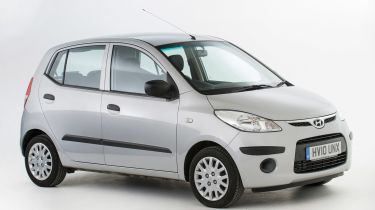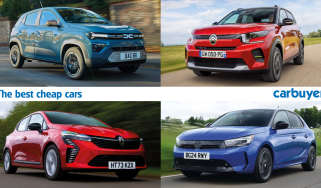Hyundai i10 hatchback (2010-2013) review
"The Hyundai i10 ticks all the boxes, is cheap to run, fun to drive and very practical - there aren't many better city cars around."
Pros
- Cheap to buy and run
- Fun to drive
- Spacious interior
Cons
- Dull interior
- No diesel option
- Tiring on motorways
The Hyundai i10 micro-car was a big success when it was launched in 2008, with the Government Scrappage Scheme helping it rack up some impressive sales. The latest i10 now offers a version of its 1.2-litre engine with more power and a tweaked exterior that adds the grille from the Hyundai ix35 SUV and slightly different rear lights.
It still feels a bit cheap inside but there’s lots of space for four adults to sit in relative comfort and it’s surprisingly fun to drive. And above all else, it is still great value for money – even compared to new ultra-cheap competition from the likes of the Dacia Sandero. The Hyundai i10 is available in three main specifications – the entry-level Classic, mid-range Active and top-of-the-range Style. You also get Hyundai's excellent unlimited-mileage/five-year ‘Triple Care’ warranty package.
MPG, running costs & CO2
The i10 is now cheaper to run than ever, with the current 1.2-litre engine and five-speed manual gearbox helping it to return 51.4mpg in combined fuel economy. CO2 emissions don’t fall below the magic 100g/km mark for tax-free motoring, but it will still only cost you £20 per year to tax. If you’re after an automatic, though, running costs are higher. All i10s come with Hyundai's excellent five-year Total Care package, including a comprehensive warranty, roadside assistance and annual vehicle health checks, so general maintenance and upkeep should be pretty cheap too.
Engines, drive & performance
Zipping around town in the i10 is fun thanks to its light, precise steering, strong engines and comfortable suspension. The 1.2-litre four-cylinder petrol engine isn't that fast, but it is pretty agile when nipping through busy traffic and crowded city streets. It’s not too bad on the motorway either, but only having five gears means you have to work the engine hard to keep up with the flow of traffic. However, the gearbox is smooth and easy to use and overall, the tall micro i10 with its skinny tyres drives pretty well.
Interior & comfort
The i10 does a good job of ironing out most bumps and potholes that it encounters, especially at lower speeds. Its small dimensions make it harder to handle big bumps when driving at faster speeds, however, and the ride does get a bit choppy as a result. The suspension is tuned for comfort and is reasonably well cushioned.
More reviews
Car trim reviews
In-depth reviews
The engines are suitably quiet when being driven around town, but start to get intrusively loud when taken up to motorway speeds – which is partly down to the lack of a sixth gear. Interior room is pretty good considering the car’s size, with two adults able to fit in the back without being too cramped. And the i10's high roof also means lots of headroom, too.
Practicality & boot space
The i10’s compact city car dimensions turn out to be more practical than many rivals. The boot offers a decent 225 litres of space, more than you’ll get in the Kia Picanto, Toyota Aygo, Suzuki Alto or Nissan Pixo. It’s nearer in size to the much bigger MINI Clubman, in fact. You’ll only find more boot space in the VW Group’s Volkswagen up!, Skoda Citigo and SEAT Mii – which all use the same underpinnings.
The i10’s five-door body is very practical, with reasonably wide door openings to make getting in the back much easier. It’s high and square shape means loads of rear space. If you go for the Comfort or Style models, you’ll also get some extra storage under the boot floor for storing valuables out of sight.
Reliability & safety
Hyundai ended its march up the rankings in the 2013 Driver Power customer satisfaction survey, dropping seven places in manufacturers rankings to come 14th. The i10 fared even worse, tumbling all the way down from seventh to 135th in the list of the top 150 cars. That’s quite a shift in fortunes, especially as there hasn’t been any recalls or major problems reported. Owners cited poor ride quality, performance and handling as key issues, while the i10 wasn’t as solid on reliability as it has been in previous polls.
Hyundai still offers an excellent five-year, unlimited-mileage warranty, with the Triple Care package ¬adding in free roadside assistance and annual vehicle health checks, so if something does go wrong it should be fixed quickly and cheaply. The interior plastics are a bit shoddy, but that’s the price you pay for it being cheaper than most of its competition. Unfortunately, it does also lag behind in the safety stakes, – with most new cars routinely securing a full five-star Euro NCAP crash safety test rating, the i10's four-star performance is a bit of a stumbling block. Newer rivals like the VW up! and Skoda Citigo certainly do hit the modern standard.
Price, value for money & options
For a long time, the i10 was one of the cheapest cars in the UK, but now the likes of budget brand Dacia are changing that. The i10 does remain the cheapest city car out there, and it remains excellent value for money, providing a high level of equipment and accessories for the money.
Resale value on the used car market should be pretty strong simply because it’s such a bargain in the first place. Insurance premiums are also among the lowest of any new car on the market, and even base models come fitted with air-conditioning, electric windows and a six-speaker stereo.










